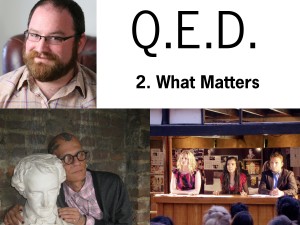Q.E.D. – Part 2: WHAT MATTERS/WHAT’S MATTER
The MAK Center Schindler House, Los Angeles
9 May 2012
Context Note: In April, May, and June of this year, Les Figues Press hosted a short series of long conversations on queer art and literature. Titled Q.E.D., in honor of Gertrude Stein’s novel by the same name (and one of the earliest coming-out stories), each Q.E.D. event explored the constructions of speech, art, literature, materiality, and sex. The conversations were moderated by Vanessa Place at the historic MAK-Schindler House, L.A.’s original nod to green architecture.
Q.E.D. Part Two featured Brian Teare, Michael du Plessis, and Lincoln Tobier.
***

Blocked off by thick and towering bamboo shoots, the hush of the Schindler House is a surprise even given its location on a quiet, residential West Hollywood street. The House belongs to the MAK Center for Art and Architecture in Los Angeles; it was originally built in 1922 as a two-family home and workspace by Rudolph M. Schindler for himself, his wife, and another couple. The House’s then-innovative indoor/outdoor, open-plan design was the basis for the “California houses” that came to litter the landscape throughout the mid-twentieth century. It is hard to imagine anyone actually living in the House as it stands now: almost entirely empty, the structure and its surroundings feel more like a church or a yoga studio. Visitors speak quietly, and it is hard not to step lightly, as if any exuberant move might knock down the concrete walls and let the rest of the world into this sacred bohemia of careful art and right living.
July 4th, 2012 / 12:00 pm
Selection from Q.E.D. – Part 1, “Things Unsaid”
The MAK Center Schindler House, Los Angeles
11 April 2012
Compiled by Chris Hershey-Van Horn
Context Note: In April, May, and June of this year, Les Figues Press hosted a short series of long conversations on queer art and literature. Titled Q.E.D., in honor of Gertrude Stein’s novel by the same name (and one of the earliest coming-out stories), each Q.E.D. event explored the constructions of speech, art, literature, materiality, and sex. The conversations were moderated by Vanessa Place at the historic MAK-Schindler House, L.A.’s original nod to green architecture.
Q.E.D. Part One featured Melissa Buzzeo, Patrick Greaney, and Simon Leung.
***

“What happens in a work of art when it seems like the artist does nothing?”—(Patrick)
July 2nd, 2012 / 12:00 pm
I’LL DROWN MY BOOK: Part 5 (Talking With the Eds.)
While working on my initial review of I’ll Drown My Book last spring (2011), I posed a few questions to the editors. Here are some of their responses…
***

To Laynie Browne:
Many of the characteristics you give for Conceptual Writing, seem to me, be able to also describe what “good experimental writing” ought to be, in some ways. Though I’m sure we would agree on the problematics of the term “experimental,” and maybe more so with “good” and “experimental” juxtaposed, I’m thinking about some of the features you mention: “a recasting of the familiar and the found,” as defined by “thinkership,” often filled with “an assemblage of voices,” “process is often primary and integrative,” “the unknown and investigative are common impulses,” “the desire to reveal something previously obscured,” etc. It seems to me many experimental writing projects would share these characteristics. Might you agree? What makes Conceptual Writing stand out from other experimental writing projects? READ MORE >
June 8th, 2012 / 12:00 pm
Requited Journal #6
As the nonfiction & reviews editor of the online journal Requited, it’s my pleasure to announce that Issue 6 just went live. In the Essays section you’ll now find:
- an autobiographical comic by Keiler Roberts (Powdered Milk Volume 5);
- a video essay by Julianne Hill (“So, Mary?”);
- and interviews with Robert Ashley, Vanessa Place, Rosmarie Waldrop, and Curtis White regarding the materials and habits of their respective writing practices (see the introductory note here).
There’s also a new review: Jeff Bursey‘s take on J. Robert Lennon’s story collection Pieces for the Left Hand.
And much more!
On The Guilt Project: Rape Morality and Law & Tragodía 1: Statement of Facts by Vanessa Place
 The Guilt Project
The Guilt Project
by Vanessa Place
Other Press, 2010
336 pages / $25 Buy from Amazon
&
Tragodía 1: Statement of Facts
by Vanessa Place
Blanc Press, 2010
430 pages / $45 (HB), $25 (PB) Buy from Blanc Press
Among the individuals in Los Angeles who are responding to heavyweight issues exists an uncanny force: Vanessa Place. A criminal defense attorney, she defends what some categorize as the lost, the wretched: indigent criminals, repeat sex offenders and violent predators. Some criminals learn valuable lessons while incarcerated; others leave prison refueled, angry and ready to re-enter what’s left of the world as a less worthy version of themselves, less interested in following pre-ordained rules. This is where Place steps in: the blurry space between offense and re-offense, perpetrator and victim, right and wrong, ethics and morality. Place explains, “I work as a combination street sweeper and factory worker. I follow what’s gone before, mopping up after the bloody mess, squaring the legal corners, assembling the lives disassembled by tragedy, and reducing reams of paper to bite-sized pellets.”(p.2)
August 8th, 2011 / 12:00 pm
I love this manifestation mode developing, objects offered to be: Statement of Facts by Vanessa Place.
1. At Examiner, an interview with Vanessa Place on L.A., Stein, La Medusa, etc.
2. At Flatmancrooked, an interview with Brian Evenson on nihilism, Kafka, film, etc.
Vanessa Place has appropriated the Warhol Factory model, available thus far as 3 text objects: Factory Work : Hellocasts by Charles Reznikoff by Divya Victor by : Poems for OodPress

